Manage backup policy
 Business
Business  Enterprise
Enterprise  Elite
Elite
Overview
A backup policy is a set of rules that defines the schedule for automatic backups that occur on virtual machines configured for backup. You can create a backup policy and assign it to one or more virtual machines. After you assign a backup policy to a virtual machine, the virtual machine is backed up according to the schedule defined in the associated backup policy.
Configuring a backup policy helps administrators simplify the management of data backups across multiple virtual machines.
Note: Backup operations follow the time zone of the backup proxy pool.
Managing retention period
Retention defines the rules for retaining your backups (recovery point) within the storage. Use the retention period to define the duration for which you want to retain your historical backups.
The objective of retention is to keep important data for future access, depending on how critical it is. Retention also ensures that backups that are no longer required are cleaned from your storage periodically, resulting in less storage utilization and costs.
The retention period would not be honored for the most recent recovery point when a server or VM or backup set is disabled. This allows you to restore the latest recovery point later if required.
Retention should consider the value of your data and the compliance requirements. The different types of data will be retained for different durations. For example, a bank's retention period for customers' financial records is different from facilities inventory records.
The main factors to consider while defining a retention period are:
- Compliance requirements
- Storage costs
- Type of data
Retention period settings
Druva follows the Grandfather-Father-Son (GFS) retention model wherein, in case of an overlap, the retention setting of the longer period (Son-Father-Grandfather relation) is considered. The recovery point is expired as per the settings of the higher period. For example, in case there is an overlap between the daily and weekly retention period, the weekly retention period is considered. So daily is the smallest unit and weekly overrides daily > monthly overrides weekly > yearly overrides monthly.
Also, Druva follows the Gregorian calendar for tracking days.
While backup schedules are configured on an hourly, daily, or weekly basis the last recovery point created by the backups on that particular day will be retained as per the retention setting.
You can define the following durations to retain recovery points.
| Retention Period | Description |
|---|---|
| Daily recovery points |
Druva retains all the recovery points that are created for the number of days specified in Daily recovery points. Druva considers midnight as the end of a day. If you have configured Druva to back up your server multiple times within a day, Druva retains all the recovery points for the days specified. |
| Weekly recovery points (Son) |
The number of weekly recovery points that Druva should retain. Druva treats the latest recovery point in the week as the weekly recovery point. Druva considers midnight on Sunday as the end of the week. |
| Monthly recovery points (Father) |
The number of monthly recovery points that Druva should retain. Druva treats the latest recovery point in the month as the monthly recovery point. Druva considers midnight of the last day of a month as the end of the month. |
| Yearly recovery points (Grandfather) |
The number of yearly recovery points that Druva should retain. Druva treats the latest recovery point in the year as the yearly recovery point. Druva considers the midnight of the last day of the year as the end of the year. |
The recovery point name displayed on the Management Console is recovery point creation time as per the server time zone, on which the backup occurred. Druva considers the time zone of the server for retaining the recovery points as per the retention setting.
Default retention period settings
If you are registering the server under default organization, Druva provides a default backup policy with the following retention settings:
- Daily recovery points: 14 days
- Weekly revisions: 4 weeks
- Monthly revisions: 3 months
- Yearly revisions: 3 years
Note: The above default retention settings are applicable for Warm storage and Long Term Retention (LTR) tiers.
Example
The following diagram illustrates the recovery points that will be available on a given day ( Feb 9 in this example) based on the retention settings you have configured. In this example the policy is created and backups start on Dec 30 of the previous year.
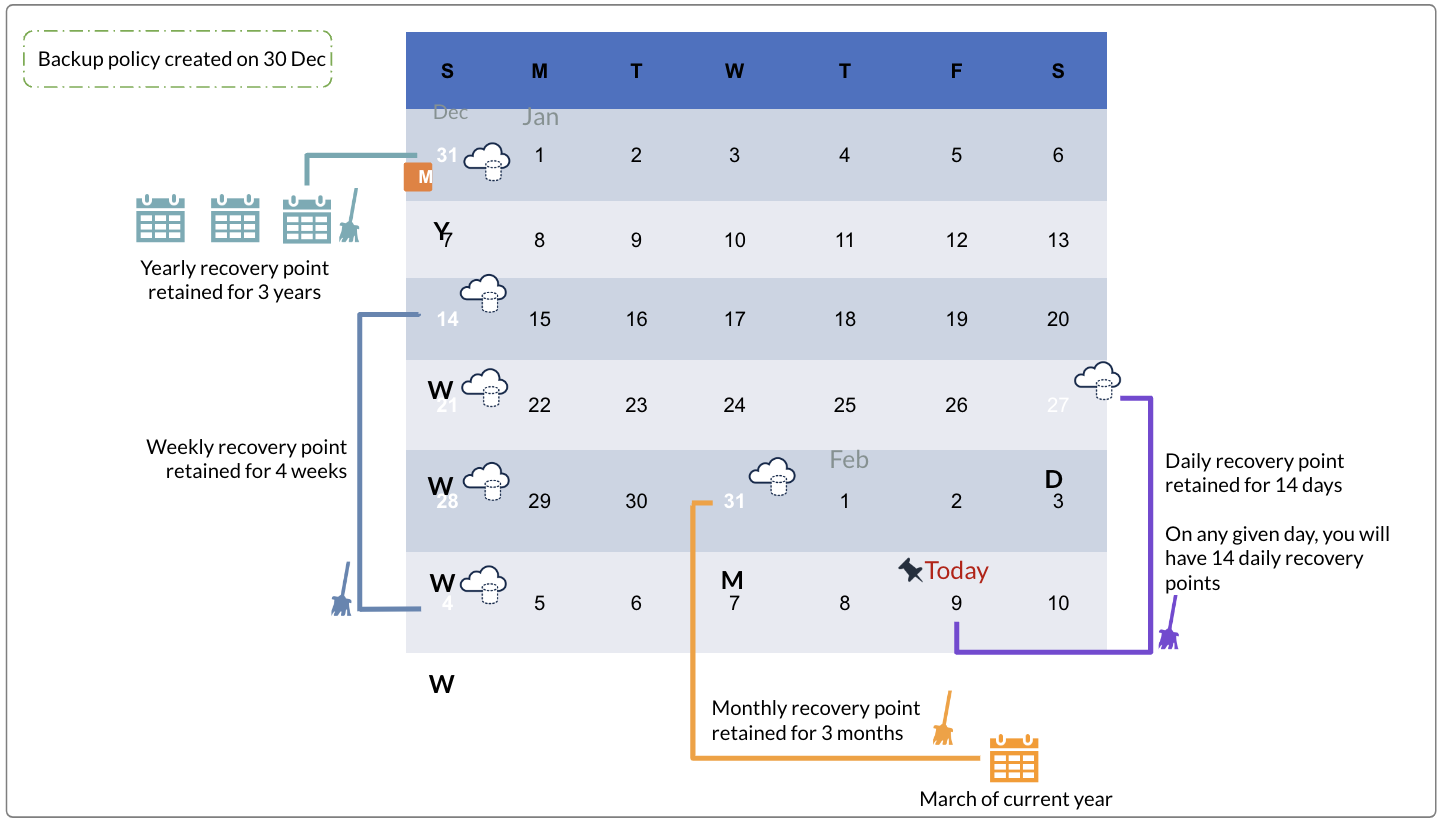
On 9 Feb you will have 17 recovery points or recovery points to restore as described in the table.
Note: Daily is the smallest unit and weekly overrides daily and monthly overrides weekly and yearly overrides monthly.
|
Recovery points resulting from |
Description |
|---|---|
| Daily retention setting | You will have 11 ( 14 daily less 2 weekly less 1 monthly) recovery points (starting from 27 Jan) created due to the daily retention settings. |
| Weekly retention setting | You will have 4 recovery points for 14 Jan, 21 Jan, 28 Jan and 4 Feb created due to the weekly settings. The weekly recovery points that coincide with the daily recovery points (28 Jan and 4 Feb) will be considered and retained as per the weekly setting. So, even though the daily retention period expires for these dates the recovery points will be retained as per the weekly settings (4 weeks). |
| Monthly retention setting | You will have 1 monthly recovery point of 31 Jan. This recovery point will be available for the next 3 months as it is a monthly retention point. So even though the 14 days daily retention period expires after 9 Feb, the recovery point will be available for the next 3 months. |
| Yearly retention setting | You will have one recovery point for 31 Dec due to the yearly retention setting. This recovery point will be available for 3 years. |
Impact of retention period settings on recovery point objective (RPO)
In continuation with the example above, so let us say malware was detected on 9 Feb evening. After investigation, it was discovered that the data till 7 Feb is corrupted. In that case, the recovery point available to you will be of 6 Feb which is available due to the daily recovery point. However, there could be a data loss of data backed between 7 Feb and 9 Feb.
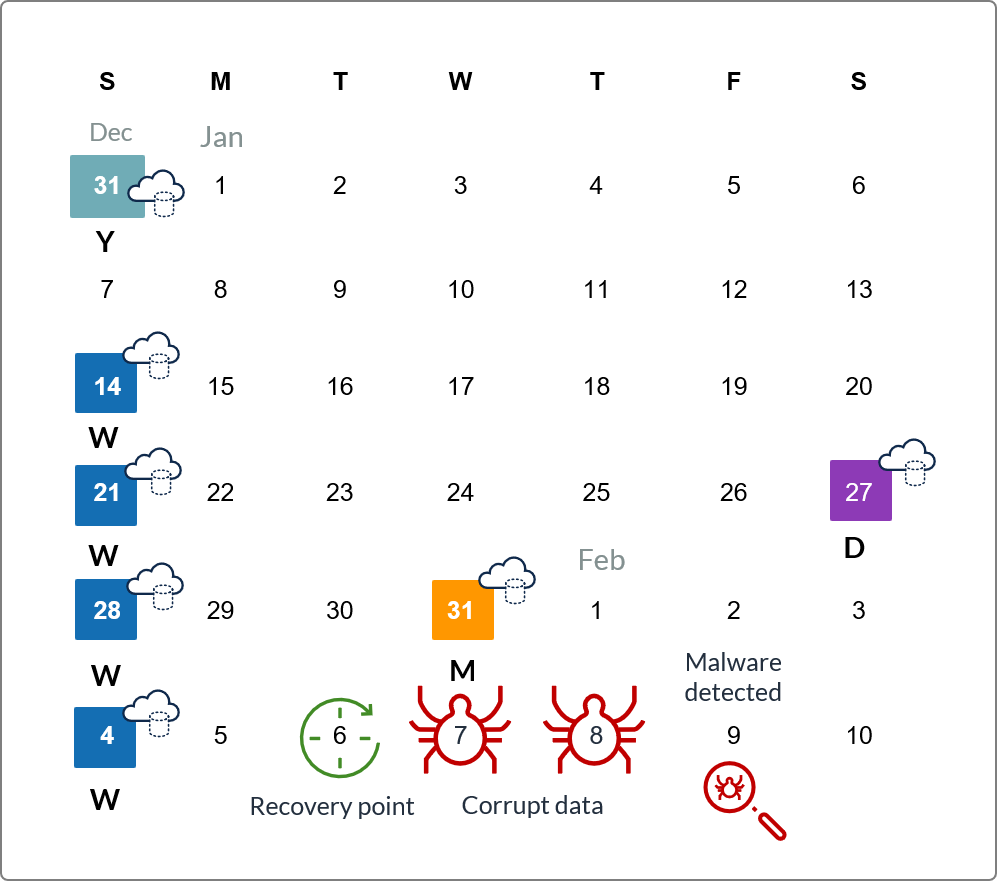
Considerations
- Any changes that you make to the existing retention policies will be applied to all the new as well as the existing recovery points.
- Retention periods are applicable for recovery points that reside on CloudCache and Druva Cloud.
- Druva runs a retention expiration algorithm to delete the recovery points that have crossed the expiration period. This algorithm does not delete thawed recovery points. For more information, see Recovery points.
Create a VMware backup policy
Add or create a new VMware backup policy based on your organization's needs to backup virtual machines based on different schedules.
Alternatively, you can copy an existing VMware backup policy and modify it to suit your needs. For more information, see Copy a VMware backup policy.
Procedure
- Log in to the Management Console.
- From the top menu bar, select your organization if organizations are enabled.
- Click Protect > VMware.
- In the left navigation pane, click Backup Policies.
- Click New Backup Policy.

- In the General tab, provide the following general information for the new VMware backup policy.
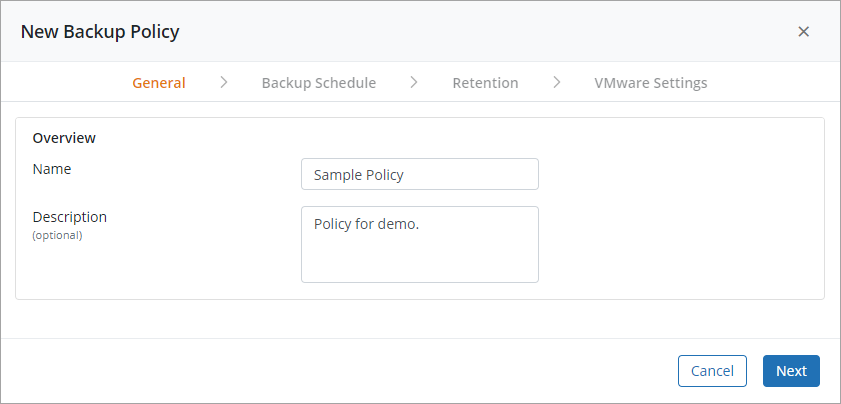
Field Description Name Type a name for this backup policy. Description Type a description for this backup policy. - In the Backup Schedule tab, specify the following settings, keeping in mind to minimize the end-user impact of the backup.
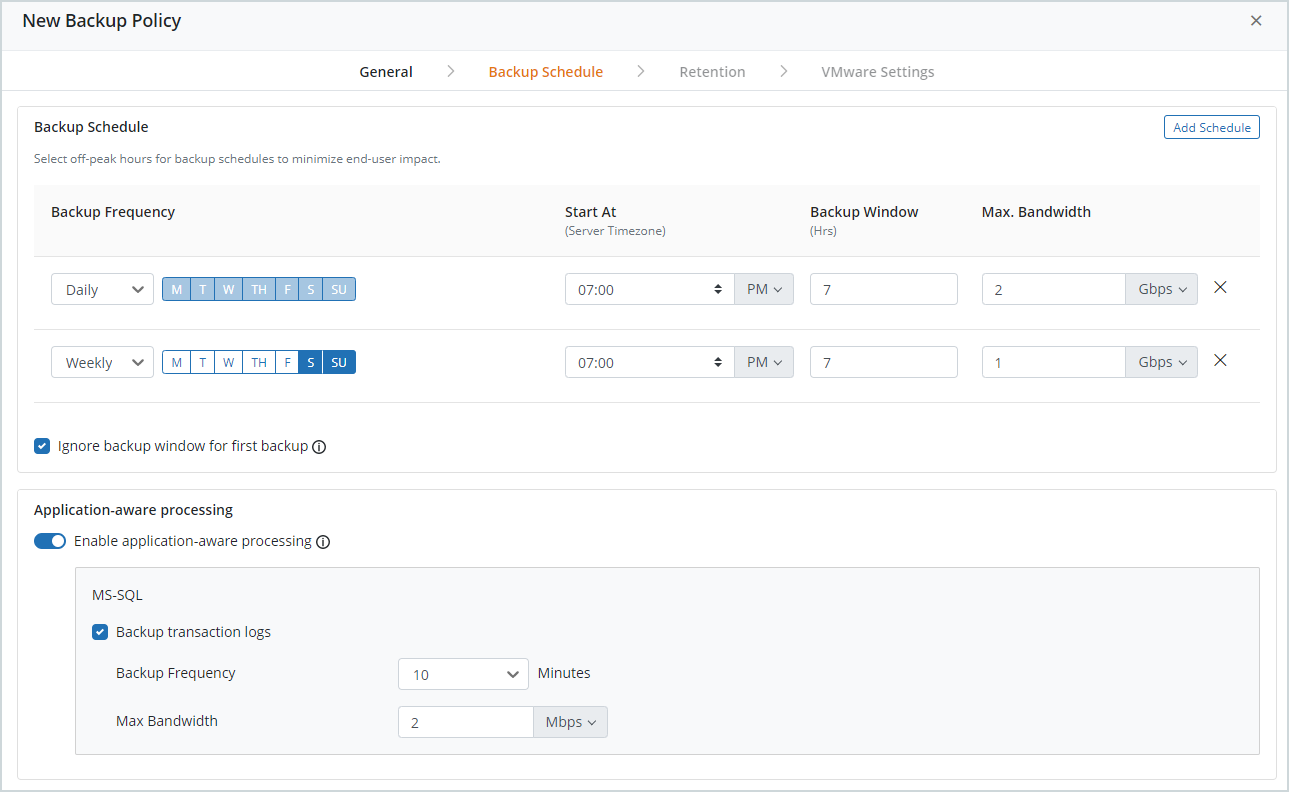
Field Description Backup schedules: Click Add Schedule to add multiple schedules. Backup Frequency Select the days on which the automatic backups should occur at the specified time.
You can schedule the frequency hourly, daily, or weekly.
Start at Select the off-peak time, in 12-hour format, when you want backups to start.
Backup operations follow the time zone of the backup proxy pool.
Backup Window Set the duration for how long the backup should run. Type the number of hours.
Example
If you set Start at to 01:00 AM and you set the duration to 6 hours, backups from your server start at 01:00 AM and stop at 07:00 AM, even if they do not complete.
Max Bandwidth The maximum bandwidth that each virtual machine can consume while backing up data to Druva. You can enter the bandwidth in Mbps or Gbps.
Note: The maximum bandwidth that a backup job can consume is 2 Gbps (2048 Mbps).
- For a scheduled backup, the job will consume the assigned bandwidth.
- However, for manually triggered backup, the job will consume the available bandwidth on your network.
Ignore backup window for first backup By default, the Ignore backup window for the first backup option is enabled. When this option is enabled, it ignores the specified backup duration until the first backup job is complete. The first backup job is complete when the first recovery point is created. You can disable this option to enforce backup duration for the first backup job. Application-aware processing Enable Application-aware processing Druva supports the backup of SQL Server databases. When you enable application-aware processing, Druva runs a backup of SQL Server instances on the virtual machine.
For more information, see:- Prerequisites for configuring virtual machines for backup to understand the prerequisites for SQL Server application-aware backups
- Process workflow of application-aware backups on VMware virtual machines to understand the SQL Server aware backup workflow on VMware virtual machines.
Backup Transaction logs Enables transaction log backups. Backup Frequency Here, if you specify an interval of 10 minutes in the transaction log backup frequency field, and the full virtual machine SQL Server aware backup got completed at 12:00 PM, the first log backup happens at 12:00 PM. If the first log backup completes at 12:05 PM, the next log backup starts according to the schedule at 12:10 PM. If the log backup runs until 12:45 PM, the next log backup starts immediately as soon as the current log backup ends. Max Bandwidth Specify the bandwidth for a transaction log backup.
Note: The maximum bandwidth that a transaction log job can consume is 2 Gbps (2048 Mbps)
- In the Retention tab, provide the following details
Note: Ensure that you enter a value in at least one of the fields. Druva treats the values in the empty fields as zero.

Field Description Daily Recovery points for Duration in number of days, for which you want to retain all the daily recovery points. Weekly Recovery points for Specify the number of weeks for which you want to retain the latest weekly recovery point. Monthly Recovery points for Specify the number of months for which you want to retain the latest monthly recovery point. Yearly Recovery points for Specify the number of years, for which you want to retain the latest yearly recovery point. Enable Long Term Retention Toggle to enable or disable LTR for the backup policy. You can enable LTR only if the retention period is greater than or equal to one year. To know more about LTR, refer to About Long Term Retention.
In the Keep recovery points in warm tier drop-down list, specify the duration in days to retain the recovery points in the warm tier. For example, 15, 30, 45, and 60 days. To know more about the impact of changing the threshold on the existing recovery points, see Impact of changing threshold on existing recovery points.
Enable Data Lock Toggle to enable the Data Lock for the backup policy. For more information about Data Lock, refer to Data Lock for preventing malicious or accidental deletion of recovery points.
Note: Once you apply Data Lock to the backup policy, you cannot:
Disable Data Lock.
Delete the recovery points, backup sets, and backup policy.
Edit the retention period in the backup policy.
Associate another backup policy to the Data Lock-enabled backup set.
- In the VMware Settings tab, specify the following settings:
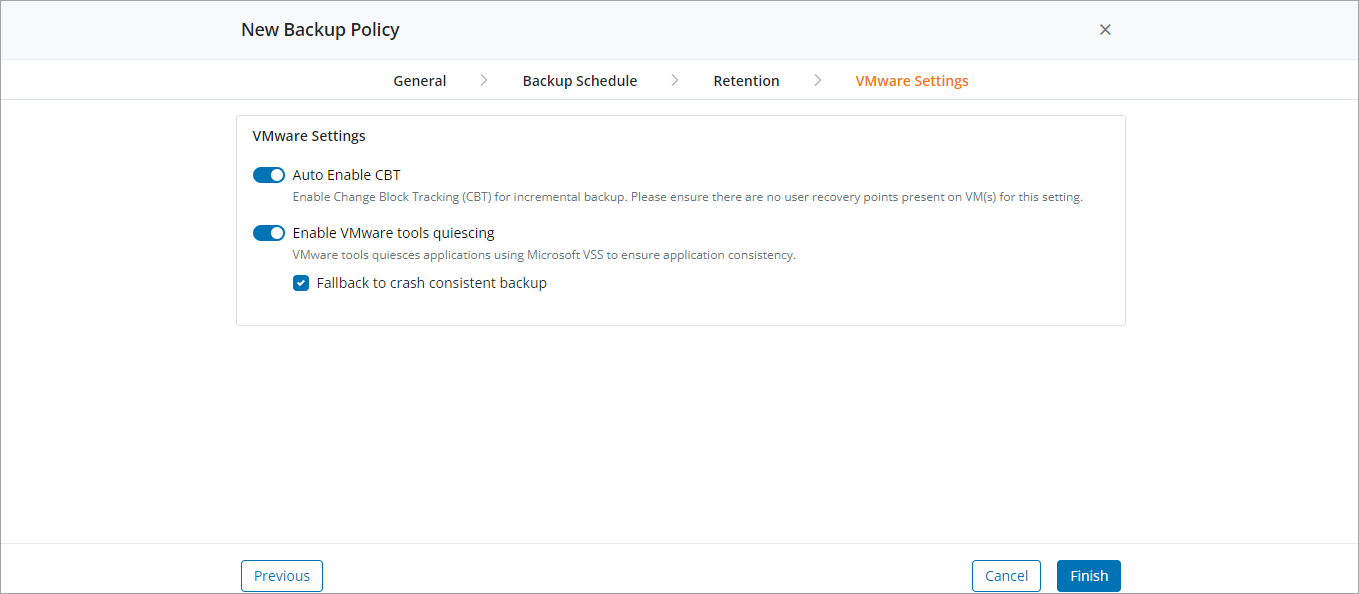
Field Description Auto-enable CBT Druva recommends that you enable Changed Block Tracking (CBT) for VMware backups. For more information about CBT, see Changed Block Tracking. Enable VMware tools quiescing
VMware tools quiesce applications using Microsoft VSS to ensure application consistency. For more information, see VMware tools Quiescing.
If Enable VMware tools quiescing toggle is turned on, the Fallback to crash consistent backup option is visible on the UI.
You can select the Fallback to crash consistent backup option to capture a crash-consistent recovery point if quiescing of VMware snapshot fails for reasons such as VM tools not installed/running/updated or VSS services-related issues on Guest OS and the backup fails.
If you select the Fallback to crash consistent backup option, a crash consistent backup is performed, and the backup status will be Successful with errors.
Note: A crash-consistent backup takes a snapshot of all the data found on a disk at the exact same time. Any information still in memory is lost.
Application-consistent backups can capture application information both in memory and in pending I/O operations.If you deselect the Fallback to crash consistent backup option and quiescing of the VMware snapshot fails, the backup will fail, and the recovery point is not captured.
-
Click Create.
Backup policy is created and listed on the Backup Policies page. You can now assign the backup policy to virtual machines. -
Click on the name of the VMware backup policy to view its details.
Update a backup policy
You can update an existing VMware backup policy anytime as per your requirements.
Procedure
- Log in to the Management Console.
- From the top menu bar, select your organization if organizations are enabled.
- Click Protect > VMware.
- In the left navigation pane, click Backup Policies.
- Select the VMware backup policy you want to update. The backup policy details are displayed.

- You can update the following settings:
- Backup policy summary
- Backup schedule
- Retention settings
- Backup settings
- For more information about the settings, see Create a backup policy.
- Click Edit in the respective section and update the settings.
Duplicate VMware backup policy 
Instead of creating a new VMware backup policy and defining each and every setting again, you can duplicate an existing VMware backup policy, and update only the required parameters according to your requirements. When you duplicate a backup policy, the newly-created backup policy details are identical to the original backup policy.
Procedure
- Log in to the Management Console.
- From the top menu bar, select your organization if organizations are enabled.
- Click Protect > VMware.
- In the left navigation pane, click Backup Policies.
- Select an existing VMware backup policy, which you want to duplicate, from the listed backup policies.

- Click Duplicate Policy. The Duplicate Policy window appears.

- The Selected backup policy field displays the name of the backup policy selected for duplication.
- In the New backup policy name, type a name for this new backup policy.
- In the Description field, type a description for this backup policy.
- Click Duplicate.
- Backup policy is created with settings similar to the original backup policy and listed on the Backup Policies page.
- Click the name of the backup policy to view its details. You can edit the settings as per your requirement and save it. You can then assign the backup policy to a virtual machine, which defines the backup schedule.
View list of virtual machines associated with a backup policy 
- Log in to the Management Console.
- From the top menu bar, select your organization if organizations are enabled.
- Click Protect > VMware.
- In the left navigation pane, click Backup Policies.
- Click the VMware backup policy for which you want to view the list of associated virtual machines. Backup policy details are displayed.
- Click on the VMs tab. The list of associated virtual machines is displayed

- Click on the virtual machine name to view its details.
Delete a backup policy 
Only a cloud administrator can remove or delete a VMware backup policy from the Druva environment based on the following criteria,
- A virtual machine does not use the VMware backup policy you intend to remove.
- If a virtual machine is using the VMware backup policy you intend to remove, update the virtual machine and apply a new backup policy to the virtual machines. To update a virtual machine, see Reconfigure a virtual machine.
Note:
- You can delete a backup policy only after 7 days of the deletion of the last configured virtual machine mapped to the policy.
- If the backup policy has Data Lock enabled, you cannot manually delete this backup policy.
Procedure
- Log in to the Management Console.
- From the top menu bar, select your organization if organizations are enabled.
- Click Protect > VMware.
- In the left navigation pane, click Backup Policies.
- Click the VMware backup policy
- Click the VMware backup policy that you want to delete. Backup policy details are displayed.
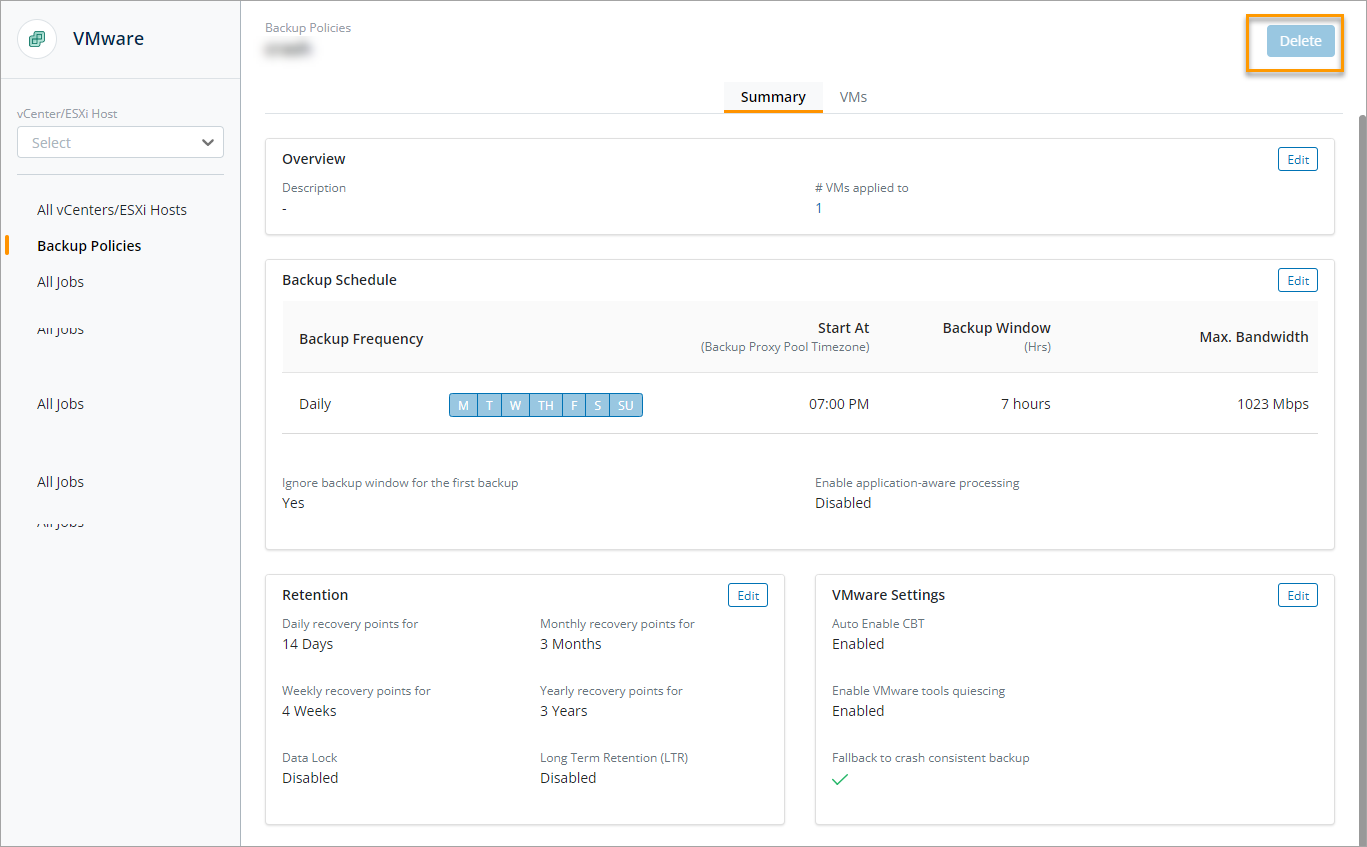
- Click Delete. A dialog box appears asking for your confirmation.
- Click Yes.

